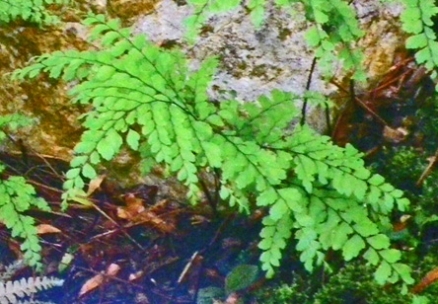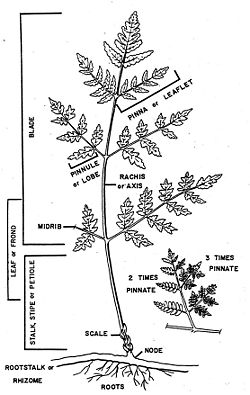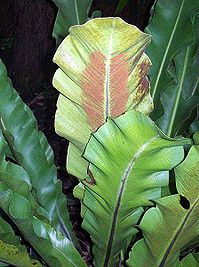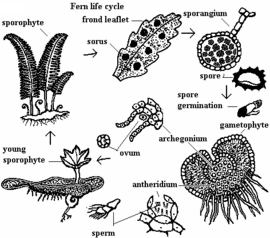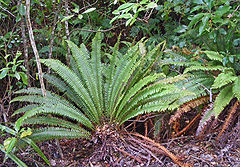Fern
A fern' is any one of a group of about 12,000 species of vascular plants[1] Lacking flowers and seeds, ferns reproduce by spores; otherwise, ferns have the major structures of flowering plants: stems and leaves; they also have rhizoids, which are root-like tissue anchoring the individual in soil. T'rue ferns are assigned to the class Pteridopsida within the phylum Pteridophyta; other classes of this phylum are considered fern allies. An alternative designation for the true ferns is the classification Leptosporangiate ferns. While ferns occur in many world regions, there is a disproportionate richness of fern species in tropical and subtropical regions, although there are many families appearing in temperate regions; moreover, numerous fern genera are quite cosmopolitan. Ferns first arose in the Carboniferous era, although but many of the current families did not appear until the late Cretaceous Period.
Contents
Morphology
The main organs and elements of ferns are:
- Rhizoids are subsurface non-photosynthetic structures that draw water and nutrients from soil. These are in all cases fibrous and resemble the corresponding root structures of flowering plants.
- Stems are typically a subsurface creeping rhizome, but sometimes manifest as an above-ground creeping stolon or an aerial erect semi-woody trunk (Cyatheaceae family) reaching heights of up to 20 metres in a few species (e.g. Cyathea medullaris in New Zealand).
- Leaves are photosynthetic structures usually called fronds, which characteristically unroll from a tight spiral termed a crozier or fiddlehead. Fronds may occur in three forms: (a) Trophophyll is a non-spore producing frond, which can photosynthesize; (b) Sporophyll is a frond that contains spores, even though they superficially resemble tropophylls and photosynthesize; and (c) Brophophyll is a frond that produces a prodigious number of spores.
Fern gametophytes are quite distinct from the corresponding organs of flowering plants. They usually have a prothallus, which is a photosynthetic structure one cell thick, that is normally heart or kidney shaped; the prothallus is characteristically three to ten millimeters in length and two to eight millimeters in width. Production of gametes from the prothallus is via antheridia (minute spheres that generate sperm), archegonia (flask shaped structure that generates one egg) and rhizoids (root resembling organs that are actually very elongated individual cells) which attach the prothallus to the subsurface soil.
The most evident part of the fern anatomy is the degree of divisions of the leaflets; this aspect is also a convenient diagnostic for identification of fern species in the field. The accompanying illustration sets forth a diagram of a bipinnate fern, with an inset showing further leaflet division of a tripinnate individual. Many ferns are simply pinnate in leaf structure.
Taxonomy
The classification of true ferns is generally governed by a scheme developed in 2006 by Smith:[2]
- Order Osmundales: Families include Osmundaceae (example genus: Todea), Hymenophyllaceae (example genus: Trichomanes)
- Order Gleicheniales: Families include Gleichniaceae (example genus: Gleichenia), Dryopteridaceae (example genus: Dryopteris), Matoniaceae (example genus: Matonia)
- Order Schizaeales: Families include Lygodiaceae (sole genus: Lygodium), Anemiaceae (example genus:Anemia), Schizaeaceae (example genus: Schizaea)
- Order Salviniales: Families include Marsileaceae (example genus: Marsilea), Salviniaceae (sole genus: Salvinia)
- Order Cyatheales: Families include Thyrsopteridaceae (example genus: Thyrsopteris), Loxsomataceae (example genus: Loxsoma), Culcitaceae (example genus: Culcita), Plagiogyriaceae (example genus: Plagiogyria), Cibotiaceae (example genus: Cibotium), Cyatheaceae (example genus: Cnemidaria), Dicksoniaceae (example genus: Calochlaena), Metaxyaceae (sole genus: Metaxya)
- Order Polypodiales: Families include Lindsaeaceae (example genus: Lindsaea), Dennstaedtiaceae (example genus: Pteridium), Pteridaceae (example genus: Aspidotis)
- Order Blechnales: Families include Aspleniaceae (example genus: Asplenium), Thelypteridaceae (example genus: Phegopteris), Woodsiaceae (example genus: Woodsia), Blechnaceae (example genus: Blechnum), Onocleaceae (example genus:Pentarhizidium)'
- 'Order Eupolypods I: Families include Dryopteridaceae (example genus: Dryopteris), Lomariopsidaceae (example genus: Lomariopsis), Tectariaceae (example genus: Tectaria), Oleandraceae (example genus: Oleandra), Davalliaceae (example genus: Araiostegia)
An alternative taxonomy was developed in the year 2009 by Chase and Reveal, but we will follow the Smith scheme.[3]
Evolution of ferns
Early direct ancestors of ferns and fern allies are thought to be Cladoxylopsids, plants thought to be some of the earliet tree-type organisms;[4] the Cladoxyopsids are thought to be leafless plants that reproduced by spores and first arose in the Devonian and Carboniferous. These early fern ancestors are extinct and are known only through the fossil record .From an evolutionary and classication sense there are two broad groups of ferns: the leptosprangiate and the eusporangiate groups. The eusporangiates are considered the most primitive and are often morphologically distinguished by the presence of more than one cell in the sporangia structure There are two extant eusporangiate fern families: the Marattiaceae and Ophioglossaceae, with a total of about 500 species.
Gleicheniales is an order which appears as early in the fossil record as the Cretaceous, and achieved an early broad distribution, occupying more extreme latitudes than at present. Some fern orders have shifted their geographic concentration as the families evolved; for example, Schizaeales had a pronounced northern hemisphere concentration as late as the Mesozoic, but by the Quaternary, the occurrences have a pronounced southern hemisphere distribution. Polypodiales are the most recently developed order of ferns, with most extant families having generally arisen and diversified within the last 100 million years.
Reproduction
As with other vascular plants, ferns manifest a life cycle with an alternation of generations, characterized by a diploid (sporophytic) and a haploid (gametophytic) phase. In contrast to gymnosperms and angiosperms, the gametophyte of a fern is a free-living organism. The complete life cycle of a typical fern consists of these steps:
- The diploid phase produces haploid spores on mature frond surfaces via meiosis
- A spore grows by mitosis into a gametophyte, which typically consists of a photosynthetic prothallus.
- The gametophyte produces gametes (often both sperm and ova on the same prothallus) by mitosis.
- A mobile, flagellate sperm fertilizes an egg which continues to be attached to the prothallus.
- The fertilized egg then becomes a diploid zygote developing by mitosis into a sporophyte, the characteristic mature plant
Ecology
Ferns often occupy inhospitable niches not desired by flowering plants. For example, clefts in rocks, which are almost devoid of soil granules, can be suitable habitat for many ferns. Practically one third of the ferns are epiphytic, often finding suitable substrate on limbs of trees in a rainforest. Other [[habitat]s] in which ferns occur are moist, shady forests and acidic wetlands including bogs, fens and swamps.[4] Examples of fern genera found in acidic wetlands are the Osmunda and Onoclea. An example genus of ferns commonly occurring in bogs is Osmunda. Azolla is a good example of a genus of ferns often found in fens. An example of a fern genus often found in swamps is Acrostichum. One should note that these alternative terms for wetland habitats have considerable overlap, and the terms are used with differing nuances in various world regions.
A large number of the true ferns depend on symbiotic associations with mycorrhizal fungi.[5] Moreover, many fern species thrive within delimited pH ranges; as one example, ferns within the genus Lygodium of eastern North America succeed chiefly in moist, intensely acidic soils, while the bulblet bladder fern Cystopteris bulbifera, with an overlapping range, only occurs on higher pH limestone substrate.
Fern spores are high in lipids, protein and calories,[6] such that they are consumed by a number of vertebrates species. The European woodmouse, Apodemus sylvaticus, is known to devour spores of the fern Culcita macrocarpa, and both the bullfinch, Pyrrhula murina, and the short-tailed bat, Mystacina tuberculata, feed on spores of true ferns.
Worldwide occurrence
The fern species of largest physical size occur in the tropics, where a considerable number occur in tree form. In warm temperate regions many occurrences are in swamps and growing in rich soils in riparian zones. Certain world regions are particularly rich in fern biodiversity; for example, in Papua New guinea, it has been estimated that over one eighth of the world's fern species can be found.[7] Some ferns are found even in extreme latitudes; in particular, the species Cryopteris fragilis occurs well up into the Arctic region.[8]
As a generalization, ferns occur more commonly and with greater diversity of taxa in the tropics and subtropics, regions in which many of the species are epiphytes.[9] On the other hand, ther is abundant evidence for Jurassic period widespread occurences in sub-Arctic latitudes, with the species of Dictyophyllum ranging from 50 degrees south to 60 degrees northern latitude.[10]
In some regions of the world certain fern species can gain dominance in a given habitat, often with undesirable outcomes. For example, in Great Britain and in New Zealand, ferns with the common name bracken can suffocate and crowd out entire plant associations, although the true species in these two cases are different. In many tropical lakes the Mosquito fern can take over large areas. In each of these examples, the ferns involved are capable of forming large colonies which effectively cover a significant area.
The Osmundales have a worldwide distribution spanning temperate and tropical regions. The Gleicheniales also have a broad distribution, but generally concentrated in the tropics and subtropics. Schizaeales, a generally cosmopolitan order, have a occurence skewed to the southern hemisphere. Salviniales have a broad tropical and temperate distribution with emphasis upon wetland occurrences. Cyatheales are found growing in tropical and subtropical areas in addition to temperate rainforests in Australia, New Zealand, and other vicinity island groups; there are even some species of this family present in southern Europe. Polypodiales are the most abundant and widespread ferns, which is not surprising since they comprise about eighty percent of extant species.[11] Blechnales is an order of mostly ground-dwelling species with an exptremely broad and cosmopolitan distribution.[11]
References
==
Citation
Hogan, C. (2013). Fern. Retrieved from http://editors.eol.org/eoearth/wiki/fern- ↑ Arthur D.Chapman. 2009. Numbers of Living Species in Australia and the World. Report for the Australian Biological Resources Study. Canberra, Australia.
- ↑ A.R.Smith, K.M.Pryer et al. 2006. A classification for extant ferns. Taxon 55(3): 705-731
- ↑ Mark W.Chase and James L.Reveal. 2009. A phylogenetic classification of the land plants to accompany APG III 161,Botanical Journal of the Linnean Society, pp. 122–127
- ↑ 4.0 4.1 Stein, W. E., F. Mannolini, L. V. Hernick, E. Landling, and C. M. Berry. 2007. Giant cladoxylopsid trees resolve the enigma of the Earth's earliest forest stumps at Gilboa. Nature, 446:904-907.
- ↑ Edgar Nelson Transeau. 1953. Textbook of Botany. Harper Publishing. 817 pages
- ↑ Klaus Mehltreter, Lawrence R. Walker and Joanne M.Sharpe. 2010. Fern Ecology. Cambridge University Press. 460 pages
- ↑ Valayamghat Raghavan. 1989. Developmental biology of fern gametophytes. Cambridge University Press. 361 pages
- ↑ K.V. Krishnamurthy. Textbook of biodiversity. Science Publishers. 260 pages
- ↑ Steve Parker. 2009. Ferns, Mosses and other Spore-producing Plants. Capstone Press
- ↑ William J.Koch. 1973. Plants in the Laboratory: A manual and text for studies of the culture, development, reproduction, cytology, genetics, collection, and identification of the major plant groups. MacMillan. 407 pages
- ↑ 11.0 11.1 Harald Schneider, Eric Schuettpelz, Kathleen M. Pryer, Raymond Cranfill, Susana Magallón, Richard Lupia. 2004. Ferns diversified in the shadow of angiosperms, Nature428 (6982): 553–557
- ↑ U.S. National Research Council. 1982. Climate in earth history. Geophysics Study Committee, American Geophysical Union. Meeting. 198 pages
- ↑ Stephen Blackmore, Susan H. Barnes. 1991. Pollen and spores: patterns of diversification. Oxford University Press. 391 pages
